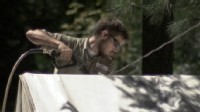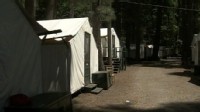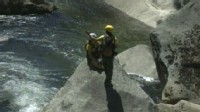Although Yosemite National Park has closed 91 cabins to prevent visitors from getting a deadly airborne disease called hantavirus , which has already killed two park-goers since July, it's not clear whether park officials have done enough to prevent the disease and inform guests -- or whether they're spreading accurate information.
A hantavirus outbreak this summer has sickened four park visitors, killing two of them. The disease comes from inhaling or ingesting particles of mouse feces or urine and has a 40 percent mortality rate.
Although it's not clear how long the virus survives outside the mouse's body, Dr. William Schaffner, the chairman of preventive medicine at Vanderbilt University Medical Center, said that when the mouse feces and urine dry, they become more dangerous because they can easily be carried into the air and breathed in.
But Schaffner's information directly conflicts with what Yosemite park ranger Kari Cobb told ABCNews.com on Wednesday: "As soon as it hits sunlight or dries, then it kills the virus," she said. "It's something that has to be contacted relatively quickly after leaving the mouse's body."
She was not available on a subsequent call to her office to discuss where she got her information.
Getty Images

Despite an email sent out this week to warn 3,000 campers who stayed in the mouse-infested cabins, this isn't the first time Yosemite has had a hantavirus case originate on its campgrounds.
A 54-year-old woman was hospitalized in Sept. 2010 after ten days of "abdominal pain, fever, nausea and shortness of breath", according to a 2010 California Department of Public Health annual report. She was diagnosed with hantavirus about two weeks after a visit to Yosemite, and noted that she saw mouse droppings on a table and watched one or two mice run across the floor.
The woman survived, but her illness sparked a hantavirus risk assessment for the park's Tulane Meadows campsite, which California Watch posted online. CDPH concluded that the park lacked a protocol for mouse prevention, was using inadequate sterilization methods, and had tents with gaps between the walls and the floor or other openings that could allow mice to get inside.
The document also suggests providing each cabin with hantavirus information, which would warn them to avoid contact with mice and report infestations to park rangers.
But campers including Salomon Varela, who visited the park days before officials announced that a camper exposed to hantavirus at Yosemite died, said no such information was provided.
"I would have liked at least a warning so I could have been vigilant about it," said Varela, who brought his 2-year-old son and allowed him to play in the dirt and under the tent during their trip.
Varela said he read about the disease when he got home, the same day his son came down with a 102-degree fever. He took the toddler to the doctor's office and waited three days for the fever to subside before he could relax.
He likened the situation to beach lifeguards who see a shark in the water but don't tell the swimmers.
"Where's the huge sign?" Valerna said. "They're warning people about the falling rocks, the bear, to stay on the trail. Why not the virus outbreak?"
Cobb said park officials didn't know about the hantavirus cases during the dates Varela visited Curry Village, Aug. 12, 13 and 14. Park officials found out on Aug. 16, the same day they sent out the news release, she said.




No comments:
Post a Comment